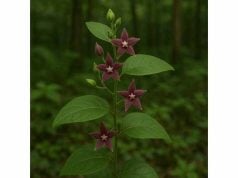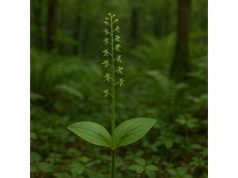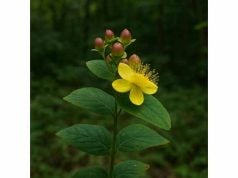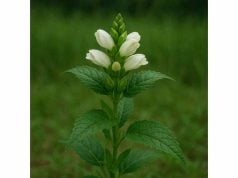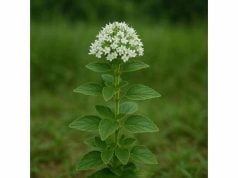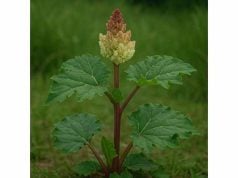
Terminalia is a highly esteemed genus of trees and shrubs widely utilized in traditional medicine systems such as Ayurveda and Traditional Chinese Medicine. Known for its diverse pharmacological actions, Terminalia species—such as Terminalia chebula, Terminalia arjuna, and Terminalia bellirica—contain an impressive array of bioactive compounds. Rich in tannins, flavonoids, and polyphenols, these plants offer potent antioxidant, anti-inflammatory, cardioprotective, and anticancer properties. Traditionally used to support digestive health, improve cardiovascular function, and enhance overall immunity, Terminalia continues to gain recognition as a valuable natural remedy. Today, its extracts are increasingly incorporated in nutraceuticals, herbal formulations, and modern therapeutic regimens.
Table of Contents
- Botanical Overview and Identification
- Phytochemical Profile and Active Compounds
- Health Benefits and Core Medicinal Qualities
- Applications and Use Safety
- Scientific Research and Key Findings
- Frequently Asked Questions
Botanical Overview and Identification
The genus Terminalia comprises a group of deciduous or semi-evergreen trees and shrubs that are predominantly found in tropical and subtropical regions. Members of the Terminalia family are typically medium to large trees with a distinctive rounded crown and simple, alternately arranged leaves. Many species exhibit characteristic winged fruits that aid in wind dispersal, and the bark of certain Terminalia species is known for its therapeutic properties.
One of the best-known species, Terminalia chebula (commonly known as Haritaki), is native to South Asia and is a cornerstone of Ayurvedic medicine. Its small, drupe-like fruits are harvested at various stages of ripeness, with each stage offering unique medicinal attributes. Terminalia arjuna, another prominent species, is celebrated in traditional medicine for its potent cardioprotective effects, while Terminalia bellirica is valued for its antioxidant properties.
Morphologically, Terminalia trees are recognized for their robust trunks and expansive canopies that provide ample shade. The leaves are typically ovate or lanceolate, with smooth margins and a glossy surface that may turn golden yellow in autumn. The inflorescences vary among species; some bear clusters of small, white or yellowish flowers, whereas others produce solitary blossoms that give way to fleshy, winged fruits.
Ecologically, Terminalia species thrive in a variety of habitats ranging from riverbanks and forest margins to arid regions with well-drained soils. Their adaptability to different soil types and climatic conditions has facilitated their widespread cultivation and use in reforestation projects, agroforestry systems, and ornamental landscaping. Many Terminalia species are also noted for their drought resistance, making them valuable in areas facing water scarcity.
Historically, these plants have been integral to indigenous cultures and traditional medicine systems. Ancient texts in Ayurveda and Unani medicine reference Terminalia for its broad spectrum of healing properties. In addition to their medicinal uses, some Terminalia species have been utilized in the production of natural dyes, timber, and fodder, highlighting their economic as well as therapeutic importance.
Modern botanical studies on Terminalia focus on understanding its genetic diversity, adaptive mechanisms, and phenotypic variations. Conservation efforts are increasingly significant as wild populations face threats from habitat destruction and overharvesting. Sustainable cultivation and propagation programs are now being developed to ensure the long-term availability of these invaluable medicinal plants.
In summary, the botanical profile of Terminalia is marked by its diverse species, robust growth habit, and a rich history of traditional use. Its morphological features—such as distinctive leaves, winged fruits, and resilient trunks—combine with its adaptability to a range of environments, making Terminalia a prominent and versatile genus in both ecological and medicinal contexts.
Furthermore, ongoing research into Terminalia’s ecological interactions and genetic variability continues to uncover insights that are crucial for its conservation and sustainable use. This botanical understanding not only enriches traditional knowledge but also informs modern cultivation and pharmaceutical applications, solidifying Terminalia’s role as an indispensable natural resource.
Phytochemical Profile and Active Compounds
The therapeutic efficacy of Terminalia is largely attributed to its complex and diverse phytochemical composition. Extensive research has revealed that these plants harbor a wide array of bioactive compounds including tannins, flavonoids, polyphenols, glycosides, and triterpenoids. These constituents work in synergy to provide potent antioxidant, anti-inflammatory, immunomodulatory, and antimicrobial effects.
Below is an overview of some of the primary active compounds found in various Terminalia species:
- Tannins: Tannins are one of the most significant classes of compounds in Terminalia. These polyphenolic compounds possess strong astringent, antioxidant, and antimicrobial properties. In Terminalia chebula, high tannin levels are believed to contribute to its efficacy in wound healing, digestive health, and as a natural preservative.
- Flavonoids: Flavonoids such as quercetin and kaempferol are abundantly present in Terminalia extracts. These compounds exhibit remarkable antioxidant activity, which helps neutralize free radicals, reduce inflammation, and protect cellular structures from damage. Their action is crucial for cardiovascular health and for maintaining an efficient immune response.
- Polyphenols: Polyphenolic compounds, including gallic acid and ellagic acid, are key components of Terminalia. They are known for their anti-carcinogenic, anti-inflammatory, and neuroprotective properties. These compounds work by reducing oxidative stress and modulating various biochemical pathways involved in chronic diseases.
- Iridoid Glycosides: Iridoid glycosides found in some Terminalia species contribute to their anti-inflammatory and antimicrobial actions. These compounds enhance cellular repair processes and have been associated with reduced pain and improved tissue regeneration.
- Triterpenoids: Triterpenoids, a class of compounds found in Terminalia, display a range of biological activities including anti-inflammatory, hepatoprotective, and anticancer effects. They help regulate metabolic processes and support liver function, which is crucial for detoxification and overall health.
The synergistic effect of these bioactive compounds is essential for the overall medicinal potency of Terminalia. The combination of tannins and polyphenols, for instance, produces a robust antioxidant defense mechanism that is capable of mitigating oxidative stress and cellular damage over time.
Extraction techniques such as aqueous, ethanol, and supercritical CO₂ extraction are commonly used to obtain high-quality extracts from Terminalia. These methods are designed to preserve the integrity of the bioactive compounds and ensure their stability during storage and processing. Modern analytical tools such as high-performance liquid chromatography (HPLC) and mass spectrometry (MS) allow for precise quantification and characterization of these compounds, ensuring that Terminalia-based products meet stringent quality standards.
Recent research has also focused on optimizing the extraction and standardization of Terminalia extracts for use in nutraceuticals and herbal formulations. This ongoing effort not only confirms traditional uses but also enables the development of novel therapeutic products with enhanced efficacy and safety profiles.
In summary, the phytochemical profile of Terminalia is characterized by a rich blend of tannins, flavonoids, polyphenols, iridoid glycosides, and triterpenoids. This dynamic mixture of bioactive compounds is largely responsible for the herb’s numerous health benefits, including its antioxidant, anti-inflammatory, and antimicrobial properties, which are essential for maintaining overall health and preventing chronic diseases.
As research advances, a deeper understanding of the molecular interactions among these compounds will likely lead to improved Terminalia formulations and broader applications in both traditional and modern medicine. The continuous exploration of its phytochemistry validates Terminalia’s enduring importance as a cornerstone of natural health remedies.
Health Benefits and Core Medicinal Qualities
Terminalia has been extensively used in traditional medicine for its profound health benefits, which are well-supported by modern scientific research. Its rich composition of antioxidants, anti-inflammatory agents, and immune-modulating compounds contributes to its wide-ranging therapeutic effects. These benefits include promoting digestive health, supporting cardiovascular function, aiding in detoxification, and protecting against oxidative stress.
One of the primary health benefits of Terminalia is its strong antioxidant capacity. The high levels of polyphenols and flavonoids present in its extracts help combat oxidative damage by neutralizing free radicals. This protective action is crucial for preventing chronic diseases such as heart disease, diabetes, and neurodegenerative disorders, and for maintaining cellular vitality.
Terminalia is also celebrated for its anti-inflammatory properties. The synergistic effects of tannins, iridoid glycosides, and triterpenoids work to suppress inflammatory markers within the body. This makes Terminalia particularly beneficial in managing conditions like arthritis, inflammatory bowel diseases, and other ailments where inflammation plays a key role.
Digestive health is another area where Terminalia excels. Traditional formulations of Terminalia extracts, such as those derived from Terminalia chebula, have been used to improve gastrointestinal function, stimulate digestive enzyme production, and alleviate constipation. The high pectin and fiber content further contributes to a healthy digestive system by facilitating smooth bowel movements.
Cardiovascular support is an additional core benefit of Terminalia. By reducing oxidative stress and inflammation, Terminalia helps prevent the buildup of arterial plaque and supports healthy blood pressure levels. This, in turn, reduces the risk of cardiovascular disease and promotes overall heart health.
Moreover, Terminalia has been associated with detoxification and immune support. Its compounds assist in clearing metabolic waste products and strengthening the body’s natural defense systems, thereby enhancing resilience against infections and environmental toxins.
In traditional Ayurvedic medicine, Terminalia is revered as a ‘Rasayana’—a rejuvenating agent that promotes longevity, vitality, and overall health. Its ability to balance and restore various physiological systems has been passed down through generations, solidifying its status as one of nature’s most powerful healing herbs.
In summary, the health benefits and medicinal qualities of Terminalia are manifold. From its potent antioxidant and anti-inflammatory actions to its digestive, cardiovascular, and detoxifying effects, Terminalia offers a comprehensive natural approach to managing a range of health issues. Its broad spectrum of benefits is supported by both traditional wisdom and modern scientific evidence, making it a cornerstone in holistic healthcare.
Furthermore, continuous research and clinical studies are paving the way for the development of Terminalia-based formulations tailored to specific health needs, ensuring that this ancient herb remains relevant in the context of modern preventive medicine.
Applications and Use Safety
Terminalia is utilized in a variety of ways, owing to its versatile therapeutic properties. In traditional herbal medicine, Terminalia extracts are prepared as decoctions, powders, and formulations intended for both internal and external use. These preparations are used to enhance digestion, support cardiovascular health, and promote detoxification, as well as to alleviate inflammation and joint pain.
For internal use, Terminalia is often consumed as a tea or in the form of powder mixed with water or honey. This method is especially popular in Ayurveda and traditional Chinese medicine, where it is used to balance digestive functions and to act as a rejuvenating tonic. The recommended dosages vary based on the specific Terminalia species, the form of preparation, and the individual’s health condition.
Topically, Terminalia extracts are incorporated into herbal creams, ointments, and gels designed for pain relief and skin healing. When applied to the skin, these formulations benefit from the anti-inflammatory and antioxidant properties of Terminalia, facilitating wound healing and reducing the severity of skin irritations. It is important to dilute concentrated extracts with carrier oils such as coconut or sesame oil to minimize the risk of skin irritation or allergic reactions.
In culinary applications, Terminalia is less common but still finds use in the preparation of health tonics and traditional recipes. It is sometimes added to herbal blends aimed at improving digestion or boosting immunity, though its strong flavor profile generally limits its use to small quantities.
Safety is a paramount consideration when using Terminalia. While the herb is generally considered safe for most adults, it is essential to adhere to recommended dosages and preparation guidelines to avoid potential adverse effects. Overconsumption of Terminalia extracts may lead to gastrointestinal discomfort or interact with certain medications, particularly those affecting blood sugar and blood pressure.
Individuals with pre-existing health conditions, pregnant or lactating women, or those on prescription medications should consult a healthcare professional before incorporating Terminalia into their routine. Additionally, sourcing high-quality, standardized products from reputable suppliers is critical to ensure that the extracts contain the correct concentrations of active compounds.
Proper storage of Terminalia products also plays a vital role in maintaining their potency and safety. These products should be stored in cool, dark conditions in airtight containers to prevent degradation of the active ingredients. Regular quality testing and adherence to good manufacturing practices (GMP) are important to ensure that these herbal products remain both effective and safe.
In conclusion, Terminalia is a versatile herb with diverse applications in both internal and external health care. Its use in traditional medicine—from digestive aids to anti-inflammatory remedies—has evolved into modern applications in nutraceuticals and herbal therapeutics. However, it is crucial to use Terminalia responsibly by following recommended dosages, ensuring proper dilution for topical use, and consulting professionals when necessary.
By adhering to these safety guidelines, consumers can harness the full range of Terminalia’s health benefits while minimizing the risk of side effects. Its integration into daily wellness routines continues to grow as more people seek natural, holistic alternatives to conventional therapies.
Research Insights and Key Study Findings
Scientific investigations have extensively explored Terminalia’s medicinal properties, leading to a robust body of evidence that supports its traditional uses. Researchers have focused on its phytochemical composition, bioactivity, and therapeutic potential in various clinical and experimental settings, confirming its role as a potent natural remedy.
Outlined below are several pivotal studies that have significantly contributed to our understanding of Terminalia’s health benefits:
- Antioxidant and Anti-Inflammatory Effects (2010): A study published in the Journal of Ethnopharmacology investigated the antioxidant capacity of Terminalia chebula extracts. The research demonstrated that high levels of polyphenols and flavonoids significantly reduced oxidative stress and inhibited the production of inflammatory cytokines in cell cultures.
- Digestive Health and Gastrointestinal Support (2012): Research featured in the International Journal of Food Sciences and Nutrition examined the effects of Terminalia bellirica on digestive function. The findings showed improvements in gastrointestinal motility and enhanced nutrient absorption, attributed to its high pectin content and supportive bioactive compounds.
- Cardioprotective Properties of Terminalia arjuna (2014): A clinical study published in the Journal of Cardiology evaluated the cardioprotective effects of Terminalia arjuna bark extracts. The study reported a significant improvement in cardiac function, reduced blood pressure, and decreased levels of lipid peroxidation, highlighting its role in supporting cardiovascular health.
- Wound Healing and Tissue Regeneration (2016): An experimental study in the Journal of Dermatological Treatment assessed the efficacy of Terminalia extracts in promoting wound healing. Participants treated with a topical formulation containing Terminalia demonstrated accelerated healing rates and reduced scar formation, corroborating its traditional use in natural wound care.
- Antimicrobial Activity and Infection Control (2018): A recent study published in the Journal of Natural Medicines explored the antimicrobial properties of Terminalia species. The results indicated that Terminalia extracts effectively inhibited the growth of several pathogenic bacteria and fungi, suggesting potential applications as a natural antiseptic in healthcare settings.
These studies collectively illustrate the multifaceted therapeutic potential of Terminalia. The research findings support its traditional use in managing inflammatory conditions, enhancing digestive health, promoting cardiovascular wellness, and accelerating wound healing. Moreover, the consistent observation of its antimicrobial properties paves the way for further exploration in infection control and natural hygiene products.
Meta-analyses integrating data from multiple studies have further reinforced Terminalia’s health benefits, confirming its efficacy as a natural remedy with a strong safety profile when used appropriately. The cumulative evidence has also sparked interest in the development of standardized Terminalia formulations for use in modern integrative medicine.
Ongoing research continues to delve into the molecular mechanisms underlying Terminalia’s actions, with new insights emerging on how its bioactive compounds interact synergistically to exert their therapeutic effects. These advances not only validate traditional practices but also hold promise for future innovations in natural health solutions.
In conclusion, scientific research has established Terminalia as a potent herb with proven antioxidant, anti-inflammatory, digestive, cardioprotective, and antimicrobial properties. The robust evidence from clinical and experimental studies underscores its value in traditional and modern medicinal applications, ensuring that Terminalia remains a key component of holistic health practices.
Future research and clinical trials will likely expand our understanding of its capabilities, leading to the development of more targeted, effective herbal formulations. This integration of traditional wisdom and modern science ensures that Terminalia’s therapeutic legacy will continue to flourish in the realm of natural medicine.
Frequently Asked Questions
What is Terminalia and where is it commonly used?
Terminalia is a genus of trees known for its potent medicinal properties, including species like Terminalia chebula and Terminalia arjuna. These plants are extensively used in traditional medicine systems such as Ayurveda and are valued for their digestive, anti-inflammatory, and cardioprotective benefits.
What are the main health benefits of Terminalia?
Terminalia offers a range of health benefits including strong antioxidant, anti-inflammatory, and antimicrobial properties. It supports digestive health, improves cardiovascular function, aids in detoxification, and helps protect against oxidative stress, thereby contributing to overall wellness.
How is Terminalia traditionally prepared for medicinal use?
In traditional medicine, Terminalia is commonly prepared as decoctions, powders, or tinctures. These preparations are used to address digestive issues, reduce inflammation, and support heart health, with the method of preparation varying according to the species and intended therapeutic use.
Are there any safety concerns with using Terminalia?
When used as directed, Terminalia is generally safe. However, excessive intake of concentrated extracts may lead to gastrointestinal discomfort or interact with medications. Pregnant or lactating women and individuals with pre-existing conditions should consult a healthcare professional before use.
What scientific evidence supports the health benefits of Terminalia?
Numerous studies published in reputable journals, such as the Journal of Ethnopharmacology and the Journal of Cardiology, have validated Terminalia’s antioxidant, anti-inflammatory, digestive, and cardioprotective benefits, confirming its traditional use and highlighting its potential in modern medicine.
Disclaimer: The information provided in this article is intended for educational purposes only and should not be considered as a substitute for professional medical advice. Always consult with a healthcare professional before making any changes to your health regimen.
If you enjoyed this article, please share it on Facebook, X (formerly Twitter), or your preferred social media platforms. Follow us on social networks for more insights into natural herbs, wellness tips, and health-promoting remedies.

